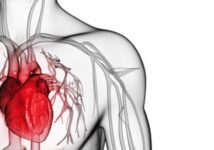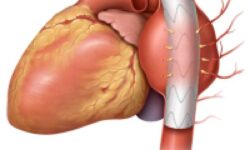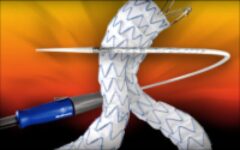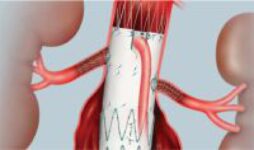Original title: Supervised Exercise, Stent Revascularization, or Medical Therapy for Claudication Due to Aortoiliac Peripheral Artery DiseaseThe CLEVER Study. Reference: J Am Coll Cardiol. 2015;65(10):999-1009. Percutaneous revascularization has been effective to treat claudication due to aortoiliac peripheral artery disease. However, supervised exercise can also offer benefits in terms of functional class and quality of life, at least in…
Ruptured abdominal aortic aneurysm: lower mortality with endovascular treatment at an experienced center.
Original title: Mortality from ruptured abdominal aortic aneurysms: clinical lessons from a comparison of outcomes in England and the USA. Reference: Karthikesalingam A et al. Lancet. 2014;383:963-969. Treatment strategy for rAAA patients may vary according to the different centers. This study analyzed in-hospital mortality, and mortality after intervention of all patients admitted with rAAA between 2005 and 2010…
Endoprosthesis for the treatment of type A aortic dissection
Original title: Application of Open Triple-Branch Aortic Arch Stent Graff for Acute Stanford Type A Aortic Dissection Reference: Fei Hua, et; al. Vascular Endovascular Surgery 47;2:109-14 Type A aortic dissection is a disease of high morbidity and mortality, especially in the early hours . Surgery is the treatment of choice but still have a significant complication rate .…
Type B Aortic Dissection over a 5-year period: lower mortality than medical therapy.
Original title: Survival After Endovascular Therapy in Patients With Type B Aortic Dissection. A Report From the International Registry of Acute Aortic Dissection (IRAD). Reference: Rossella Fattori et al. J Am Coll Cardiol Intv 2013;6:876–82. Endovascular repair of the thoracic aorta is becoming a viable alternative, though its efficacy had not been followed up longer than two years.…
Treatment strategies in Endoprosthesis with documented infection.
Original title: A 14-years Experience with Aortic Endograft Infection: Managemente and Results. Reference: O.T.A. Lyons, et al. European Journal of Vascular and Endovascular Surgery 46;3:306-313 The infection of an Endoprosthesis is a rather infrequent complication, undesirable and associated with poor evolution, with little information in the literature and an unclear treatment strategy. Traditionally, the prosthesis infection has…
Chimney technique for type B aortic dissection
Original title: The Single-centre Experience of the Supra-arch Chimney Technique in Endovascular Repair of Type B Aortic Dissections. Reference: Y. Zhu et al. European Journal of Vascular and Endovascular Surgery Volume 45 Issue 6 June/2013. Endovascular repair of type B aortic dissection (TEVAR) involving the arch, requires special techniques to preserve supra aortic vessels as fenestrated prostheses or…
MRI more sensitive for diagnosing endoleaks after stent
Original title: Magnetic Resonance Imaging is More Sensitive than Computed Tomography Angiography for the Detection of Endoleaks after Endovascular Abdominal Aortic Aneurysm Repair: A Systematic Review. Reference: J. Habets et al. European Journal of Vascular and Endovascular Surgery Volume 45 Issue 4 April/2013 Currently computed tomography angiography (CTA) with late stages is considered the most appropriate method to…
Stanford Type A Aortic Dissection Can Be Treated with Endoprosthesis
Original title: Endovascular Repair of Ascending Aortic Dissection. A Novel Treatment Option for Patients Judged Unfit for Direct Surgical Repair. Reference: Qingsheng Lu, et al. J Am Coll Cardiol 2013;61:1917–24. The dissecting aneurysm Type A represents 60% or aortic dissections and a real challenge as regards both therapeutics and the adequate moment to perform it, due to the…
Equivalent results for Zenith and Endurant devices for aneurysms with unfavorable necks.
Original title: Outcomes of Endovascular Aneurysm Repair with 2 different Endograft Systems With Suprarenal Fixation in Patients With Hostile Infrarenal Aortic Anatomy. Reference: George A. Antomiuo et al. Vascular Endovascular Surgery 47(1):9-18 The unfavorable or hostile anatomy of abdominal aortic aneurysms is a limitation of endovascular treatment and is related to complications after implantation such as migration, the…
Chronic Type B Dissection, better with endoprosthesis than with medical treatment
Original title: The results of stent graft versus medication therapy for chronic type B dissection Reference: Xin Jia et al. J Vasc Surg 2013;57:406-14 In many institutions patients with Chronic Stanford Type B Aortic Dissection is most often treated medically, and the thoracic endovascular aortic repair implant TEVAR or the surgical procedure are reserved for those who evolve…
Fenestrated prosthetics versus surgery for aneurysms of the abdominal aorta with hostile neck
Original title: Comparison of fenestrated endovascular and open repair of abdominal aortic aneurysms not suitable for standard endovascular repair. Reference: Rana Canavati et al. J Vasc Surg 2013;57:362-7. Studies in patients with infrarenal abdominal aortic aneurysm that could receive a standard stent versus conventional surgery, showed reduced perioperative mortality with endovascular treatment. However, these same results in patients…










